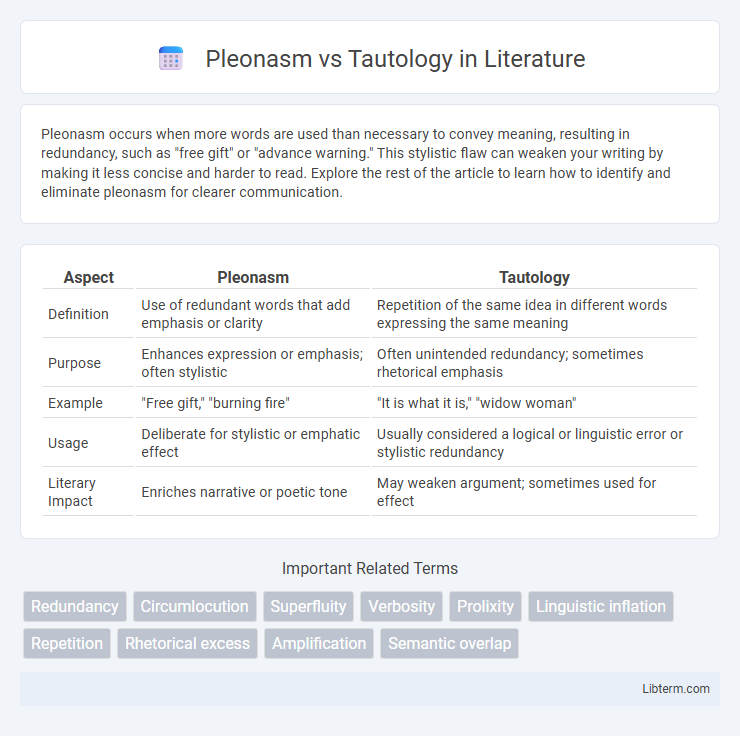Pleonasm occurs when more words are used than necessary to convey meaning, resulting in redundancy, such as "free gift" or "advance warning." This stylistic flaw can weaken your writing by making it less concise and harder to read. Explore the rest of the article to learn how to identify and eliminate pleonasm for clearer communication.
Table of Comparison
| Aspect | Pleonasm | Tautology |
|---|---|---|
| Definition | Use of redundant words that add emphasis or clarity | Repetition of the same idea in different words expressing the same meaning |
| Purpose | Enhances expression or emphasis; often stylistic | Often unintended redundancy; sometimes rhetorical emphasis |
| Example | "Free gift," "burning fire" | "It is what it is," "widow woman" |
| Usage | Deliberate for stylistic or emphatic effect | Usually considered a logical or linguistic error or stylistic redundancy |
| Literary Impact | Enriches narrative or poetic tone | May weaken argument; sometimes used for effect |
Understanding Pleonasm: Definition and Examples
Pleonasm involves the use of more words than necessary to convey meaning, often leading to redundancy, such as the phrase "free gift," where "gift" implies something given without cost. It differs from tautology, which repeats the same idea using different words for emphasis, like "widow woman." Understanding pleonasm helps improve writing clarity by eliminating unnecessary expressions that do not add new information.
Tautology Explained: Meaning and Usage
Tautology refers to the redundant repetition of the same idea using different words, often considered a logical error or stylistic flaw in writing and speech. It emphasizes the unnecessary amplification of meaning without adding new information, such as the phrase "free gift" or "true fact." Understanding tautology is crucial in improving clarity and conciseness by eliminating repetitive expressions that do not enhance the intended message.
Key Differences Between Pleonasm and Tautology
Pleonasm involves using more words than necessary to convey meaning, such as "free gift" or "true fact," emphasizing redundancy at the word level. Tautology repeats the same idea in different words or phrases for emphasis or clarity, like "widow woman" or "safe haven," focusing on conceptual reiteration. The key difference lies in pleonasm's lexical redundancy versus tautology's semantic repetition within a sentence.
Common Pleonasm in Everyday Language
Common pleonasm in everyday language includes redundant expressions such as "free gift," "true fact," and "advance planning," where extra words are unnecessarily repeated to emphasize meaning. Pleonasm involves the use of more words than necessary to convey an idea, often for stylistic effect or emphasis. Tautology, by contrast, repeats the same meaning with different words, like "each and every," focusing on redundancy in semantic content rather than grammatical form.
Examples of Tautology in Writing and Speech
Examples of tautology in writing and speech include phrases like "free gift," "advance planning," and "true fact," where words redundantly express the same idea. These redundancies can weaken clarity and conciseness, often occurring in everyday language or legal documents emphasizing certainty. Identifying tautologies helps improve communication by eliminating unnecessary repetition and enhancing the precision of expression.
Why Pleonasm Occurs: Causes and Purposes
Pleonasm occurs due to redundancy in language, where extra words repeat an idea for emphasis or clarity, such as "burning fire" or "free gift." It often arises from a desire to reinforce meaning, aid comprehension, or follow rhetorical tradition in speech and writing. Pleonasm serves purposes like stylistic effect, emotional impact, or ensuring understanding in complex communication.
The Role of Tautology in Rhetoric and Logic
Tautology plays a crucial role in rhetoric by reinforcing arguments through deliberate repetition of meaning, thereby enhancing clarity and emphasis. In logic, tautologies are statements that are universally true regardless of variable values, serving as foundational truths that support logical deductions and proofs. While pleonasm involves redundant wording for stylistic effect, tautology provides essential logical certainty and persuasive strength in communication.
Pleonasm vs Tautology: Semantic Nuances
Pleonasm involves the use of more words than necessary to convey meaning, often resulting in redundancy within a phrase, such as "free gift" or "advance warning," emphasizing semantic excess. Tautology, by contrast, entails the redundant repetition of the same idea using different words, like "repeat again" or "end result," reinforcing the same concept unnecessarily. The semantic nuance lies in pleonasm's focus on superfluous expression for emphasis or stylistic effect, whereas tautology centers on logical redundancy that offers no new informational value.
Avoiding Redundancy in Effective Communication
Pleonasm and tautology both involve redundancy, but pleonasm uses unnecessary words that repeat meaning within a phrase, while tautology repeats the same idea in different words. Avoiding redundancy in effective communication enhances clarity and conciseness by eliminating superfluous expressions like "free gift" or "repeat again." Clear, precise language ensures messages are understood quickly and prevents misinterpretation, making communication more efficient and impactful.
Best Practices for Writers: Pleonasm and Tautology
Writers should avoid pleonasm by eliminating redundant words that unnecessarily repeat the same meaning, such as "advance planning" or "true facts," to maintain clarity and conciseness. To manage tautology, authors must ensure each word adds unique information rather than restating an idea with synonyms like "free gift" or "end result," which can weaken writing impact. Employing precise language and thorough revision helps refine text, enhancing readability and professionalism in content.
Pleonasm Infographic

 libterm.com
libterm.com